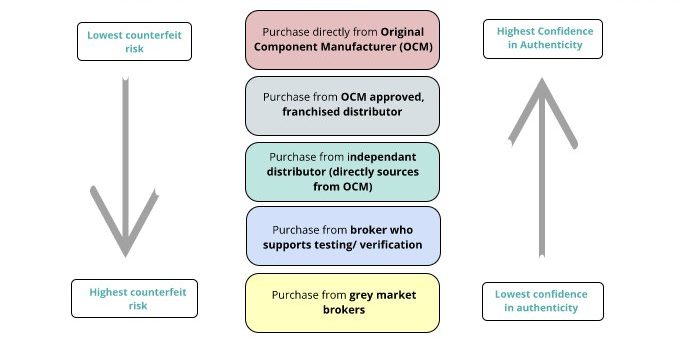 The most simple solution to avoid counterfeit components is to buy directly from the Original Component Manufacturer (OCM). However, as we know for the vast majority of us this is not possible. Therefore, you need to decrease the chances of purchasing counterfeit components which can have a negative impact on product compliance, safety, quality, reliability and more, by following these simple guidelines.
The most simple solution to avoid counterfeit components is to buy directly from the Original Component Manufacturer (OCM). However, as we know for the vast majority of us this is not possible. Therefore, you need to decrease the chances of purchasing counterfeit components which can have a negative impact on product compliance, safety, quality, reliability and more, by following these simple guidelines.
1- Validate Suppliers
If you are not able to buy directly from the manufacturer the first step in ensuring you do not deal in counterfeit components is to make sure you validate the genuity of any supplier. You can check the ECIA Authorised (http://www.eciaauthorized.com) website for approved distributors. You can also check directly with a manufacturer if a distributor is a genuine supplier of their products. Many manufacturers also offer lists of approved suppliers which can be useful when identifying genuine sources.
2- Request documentation
An initial way to check the genuity of components is to check the documentation. Speak with your supplier and request a manufacturer compliance certificate. Any good supplier will have a policy in place and will be committed to combating counterfeit components. In the case that the supplier refuses to produce this information should set alarm bells ringing. It should be agreed that payment is only due when satisfactory documentation can be produced to verify the origin of the goods. Request an unbroken chain of custody which will help to ensure that the part has not been tampered with.
3- Inspect the components
Do a visual inspection under a microscope using a known legitimate part for comparison, ideally from the same manufacturer. Look at the line marking quality; clean lines which are identical and legible indicate authentic components whereas illegible ones will normally imply poor equipment has been used for the markings. Compare the legs pins and leads ensuring that there are the same quantities and sizes. Check all printing style fonts, any company logos and alignment of all text as well as code formats. Check for obvious signs like misspellings. The list of things to look for could go on but using common sense will point at what to look for. If unsure, contact the manufacturer and remember to keep in mind that sometimes components can be manufactured in different facilities resulting in slight differences.
4- Invest in Training
Ensure that all of your staff are correctly trained in identifying and avoiding counterfeit components. Anything suspicious should be identified and reported immediately for further investigation and testing.
For more information please feel free to contact us or visit our Materials Management solutions.

